 |
 |
 |
 |
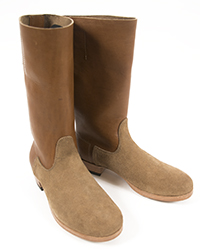
Reproduction WWII German
Jackboots
|

Steel hobnails and heel irons
|
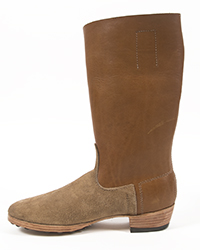
Tapered stacked heels
|
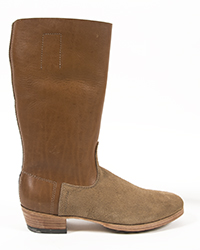
Flesh out toes, grain out shafts
|
|
|
|
|
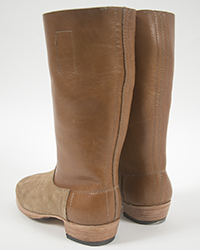
32-35cm shafts
|
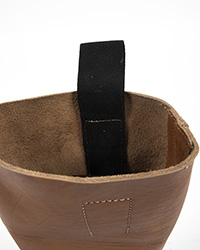
Correct black HBT web
pulls
|
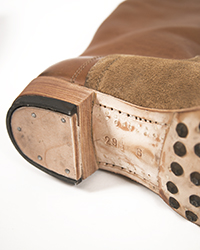
Offset heel irons,
steel shanks
|
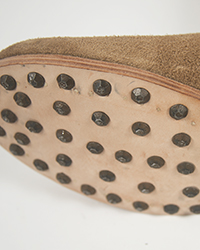
Forged steel hobnails
not cast zinc junk
|
|
|
|
|

Exact same pair of boots in preceding
photos.
Dyed, treated, greased, wetted...
|

...and broken in by walking
around the warehouse for
a morning.
|

WWII sizing tables from
Hdv 337
|
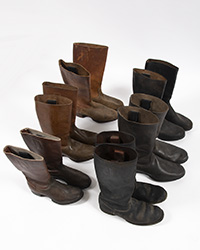
Yes, we have some originals
to use for reference
|
|
|
|
|
|
|
|
|
|
|
|
|
|
New Texled brand reproduction WWII German Marschstiefel by ATF. Our boots are the best available and the only ones with a one year warranty. They are made in North America with genuine cow leather, steel shanks, correct WWII construction & sizing, and forged heel irons and hobnails.
These are an entirely new product, with zero connection to any other or previous brand or generation of reproduction boots in the universe. Three years ago we started with a clean slate, and partnered with a US shoe manufacturer to rectify the shortcomings of just about all other (past & present) WWII German boots.
Our jackboots are a recreation of the most typical wartime variant featuring 32-35cm high, steel hobnails & heel irons, grain out shafts, and flesh out, unboxed, tapered profile toes (commonly referred to as "shark nose" by enthusiasts.) Our stitch patterns, lasts, heel and sole designs all came from real WWII boots.
As usual, we started with authentic period boots from which the patterns were developed, and then had cutting dies and custom lasts made. We then had a light brown, vegetable tanned leather specifically made to match the unissued original boots. These are made from genuine North American cowhide, not Asia water buffalo.
Yes, they have the history-critical wood pegged soles. Those little things necessitated the boots be made at the manufacturer's plant in Mexico since their facility on this side of the border lacked that ability. Like WWII boots, the soles are stitched and pegged in place. However, the pegs and stitches are superfluous- they are only for appearance sake. Unlike the old models, the soles and heels on our boots are also chemically bonded together and to the uppers. There should be zero heels falling off, soles flapping like beagle tongues nor cracking arches or anything else of the like.
The soles also feature steel shanks, which are found in many (but not all) original jackboots. Finally, the pull straps are black HBT cotton tape we had reproduced in the USA- not the thick, wonky colored webbing found in many other reproductions. Our boots are assembled with (history cries) a heavy nylon boot thread. This will not rot or decay like the linen and cotton used on WWII boots.
Hobnails: The nails were a major obstacle- actually, doing them correctly was the challenge. At one point we found a German company that thought they could make them, but failed. Only the Communists were able to pull it off- but they ended up costing more than originals. Most (likely all) of the reproduction nails are cast, usually from a mix of zinc, aluminum and manganese. They are brittle and don't stay in very well. We were able to get forged steel nails made, like originals. They are the factory type nails with two sharp, slightly curved prongs- when hammered in, they spread, making them very tough to remove, a bit like porcupine quills.

|
Some heel irons have scuffs in their paint
from the heels being sanded during production.
This is irrelevant as the rest of the finish
will be scraped off once the boots
are worn on rough surfaces. |
Heel Irons: Like the nails, our heel irons are not the usual cast reproductions that wear quickly and often crack. Ours are steel, with the offset "hidden" nails- the most prevalent type found on WWII boots.
Ankles: These do not have "swamp ankles" like most reproductions. The circumference of the heel and ankle is such that a firm tug is required to get them on- just like real jackboots or any other quality pull on boot. This prevents your heel from riding up too high when walking and it how the boots are supposed to fit. A few people with unusually high arches may not be able to fit in them.
Sizing: We used metric sizing for our German boots- it's very simple to use and accurate. If you know your metric or US size, no problem. We put them both in the dropdown box.
How do these run? On the money.
Calf sizes: The diameter of the calves increases slightly as the sizes get larger. They will take up to 16-17" calves. At this time, we have no ability or order custom sizes.
Widths: Regular and wide. In the metric size this is represented by "6" (regular) or "9" (wide). Very simple.
Custom sizes/ boots? Not possible.
Warranty: 1 year repair or replacement in the event of sole and/ or heel failure. As the bottoms are chemically bonded on, a loose stitch or lost pegs will not cause the sole or heel to fall off. The warranty essentially comes into effect if the sole snaps in half or falls off.
If you run marathons in them and wear the soles down to nothing, it's up to you to go see a cobbler. This is null & void if the problem is due to wear & tear, failure to maintain the leather, misuse or abuse (such as drying in an oven.)
Color: The German military issued their boots in brown. The individual soldiers then blackened and polished them as part of setting up their kit. Why was this done? We aren't sure. Are we sure of this? Yes. 100%. It's historical fact.
Care/ break in: Unlike modern boots, these require the wearer to break them in- if you try to do a 10 mile hump right out of the box, you and your feet will regret it. Break in is essentially molding the boots to your feet, and it's easy to do. First, dye your boots, then "dub" them with some form of shoe grease- Snoseal and Huberd's being the best and comparable to one another. Polish them if you choose. Afterwards, simply get them wet (I fill them full of water and let them sit for a few minutes), then put them on and wear them around until they are dry. Periodically (depending on how and how frequently you use them) they will need another coat of shoe grease.
Wet boots: Never EVER dry them with heat- that means do not place them in front of a fire, in an oven, a clothes dryer or any other heating device. Simply let them air dry- stuffing newspapers inside will help draw the moisture out faster.
|
|
 |
 |
 |
 |


|